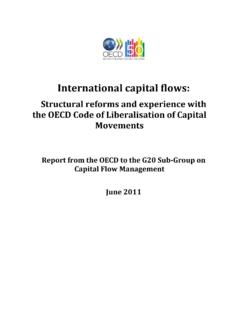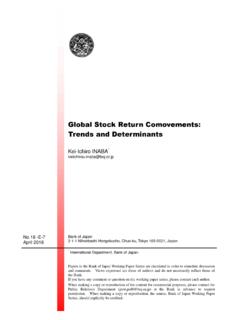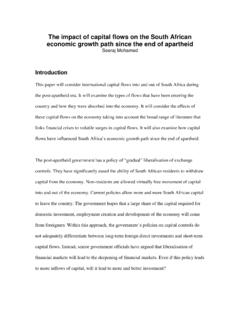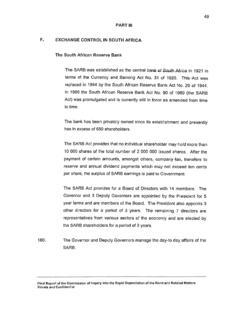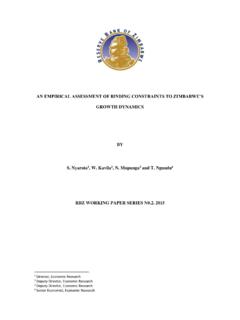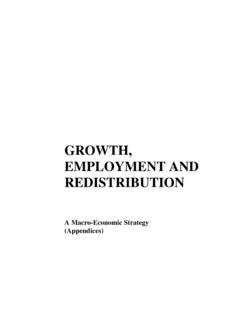Transcription of OECD Code of Liberalisation of Capital Movements
1 OECD code of Liberalisation of Capital Movements2018 OECD code OF Liberalisation OF Capital Movements ORGANISATION FOR ECONOMIC CO-OPERATION AND DEVELOPMENT OECD (2018), OECD code of Liberalisation of Capital Movements , 2018 3 FOREWORD This publication presents the full text of the OECD code of Liberalisation of Capital Movements under which adhering countries have accepted legally binding obligations. It allows a comparison of the degree of Liberalisation achieved by each adhering country in regard to international Capital Movements .
2 This edition shows all changes in the positions of adhering countries as updated by the OECD Investment Committee or Decisions of the OECD Council as of March 2018. Note: This publication is updated whenever the reservations and/or exceptions of an adhering country are modified by the OECD Investment Committee or the OECD Council. However, an amendment in the underlying regulations does not automatically or immediately lead to an amendment of the reservations or exceptions: this requires notification of the amendment by the country to the OECD, as well as a formal decision by the OECD Investment Committee or the OECD Council.
3 The OECD is not liable for any damage resulting from incomplete or inaccurate information in this publication. 4 INTRODUCTION The code of Liberalisation of Capital Movements was born with the OECD in 1961 at a time when many OECD countries were in the process of economic recovery and development and when the international movement of Capital faced many barriers. For more than 50 years, the code has provided a balanced framework for countries progressively to remove barriers to the movement of Capital , while providing flexibility to cope with situations of economic and financial instability.
4 Throughout this period, the OECD has provided a forum for international dialogue and co-operation. Under the code , an adhering country is entitled to benefit from the Liberalisation of other adhering countries regardless of its own degree of openness. The code recognises that Capital controls can play a role in specific circumstances. But because beggar-thy-neighbour approaches can have negative collective outcomes, countries have agreed under the code to well-tested principles such as transparency, non-discrimination, proportionality and accountability to guide their recourse to controls.
5 In the context of renewed discussions on reform of the international monetary system, including Capital flow management, the G20 benefits from the work of the OECD on Capital Movements . All 35 OECD countries, which include a majority of G20 members, adhere to the code . Since 2012, the code has also been open to non-OECD countries. In 2016, adhering countries adopted terms of reference for a review of the code with a view to strengthening it and ensuring its continued relevance. The review will facilitate collective action by boosting transparency and shared understandings on good practices relating to managing and liberalising Capital flows.
6 5 TABLE OF CONTENTS FOREWORD .. 3 INTRODUCTION .. 4 PREAMBLE .. 8 Part I UNDERTAKINGS WITH REGARD TO Capital Movements 9 Article 1 General undertakings .. 9 Article 2 Measures of Liberalisation .. 9 Article 3 Public order and security .. 10 Article 4 Obligations in existing multilateral international agreements .. 10 Article 5 Controls and formalities .. 11 Article 6 Execution of transfers .. 11 Article 7 Clauses of derogation .. 11 Article 8 Right to benefit from measures of Liberalisation .. 12 Article 9 Non-discrimination .. 12 Article 10 Exceptions to the principle of non-discrimination: Special customs or monetary systems.
7 12 Part II PROCEDURE .. 13 Article 11 Notification and information from members .. 13 Article 12 Notification and examination of reservations lodged under article 2(b) .. 13 Article 13 Notification and examination of derogations made under article 714 Article 14 Examination of derogations made under article 7: Members in process of economic development .. 15 Article 15 Special report and examination concerning derogations made under article 7 .. 16 Article 16 Reference to the Organisation - Internal arrangements .. 17 Article 17 Reference to the Organisation - Retention, introduction or reintroduction of restrictions.
8 17 Part III TERMS OF REFERENCE .. 18 Article 18 Investment Committee - General tasks .. 18 Article 19 Investment Committee - Special 18 Part IV MISCELLANEOUS .. 20 6 Article 20 Definitions .. 20 Article 21 Title of decision .. 21 Article 22 Withdrawal .. 22 Annex A Liberalisation Lists of Capital Movements .. 23 LIST 23 LIST B .. 31 Notes and references to Annex A .. 36 Annex B Reservations to the code of Liberalisation of Capital Movements 37 AUSTRALIA .. 38 AUSTRIA .. 43 BELGIUM .. 44 CANADA .. 45 CHILE .. 48 CZECH REPUBLIC .. 54 DENMARK .. 56 ESTONIA .. 57 FINLAND .. 59 FRANCE.
9 61 GERMANY .. 63 GREECE .. 64 HUNGARY .. 66 ICELAND, .. 68 IRELAND .. 70 ISRAEL .. 71 ITALY .. 73 JAPAN .. 74 KOREA .. 75 LATVIA .. 78 LUXEMBOURG .. 80 MEXICO .. 82 NETHERLANDS .. 89 NEW ZEALAND .. 90 NORWAY .. 92 POLAND .. 94 PORTUGAL .. 97 SLOVAK REPUBLIC .. 98 SLOVENIA .. 99 SPAIN .. 100 SWEDEN .. 101 SWITZERLAND .. 103 TURKEY .. 107 7 UNITED KINGDOM .. 111 UNITED STATES .. 115 Annex C Decision of the Council Regarding the Application of the Provisions of the code of Liberalisation of Capital Movements to Action Taken by the States of the United States .. 116 Annex D General List of International Capital Movements and Certain Related Operations.
10 118 Notes to Annex D .. 127 Annex E Decision of the Council Regarding Measures and Practices Concerning Reciprocity and/or involving Discrimination among Investors Originating in Various Member Countries in the Area of Inward Direct Investment and Establishment .. 128 AUSTRIA .. 130 BELGIUM .. 130 CANADA .. 130 FRANCE .. 131 GERMANY .. 131 GREECE .. 131 ICELAND .. 132 IRELAND .. 132 ITALY .. 132 SWITZERLAND .. 132 UNITED STATES .. 132 APPENDIX 1. LIST OF COUNCIL ACTS INCLUDED IN THE PRESENT EDITION OF THE code .. 133 APPENDIX 2. DECISION ON ADHERENCE OF NON-OECD COUNTRIES TO THE code .










